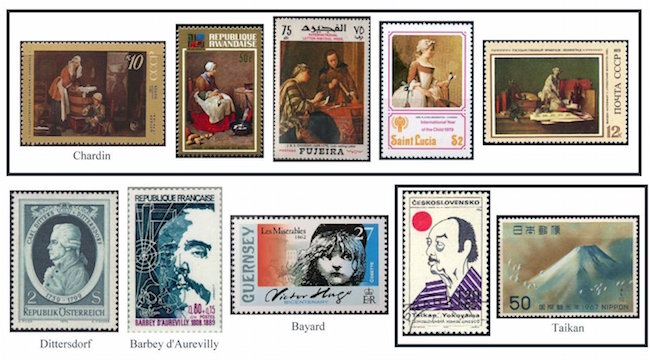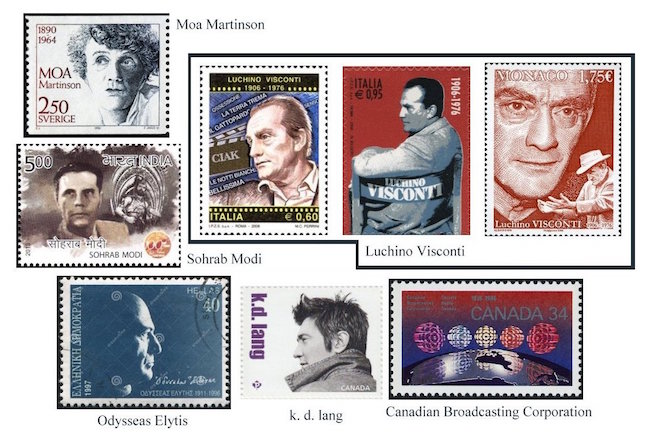The Arts on Stamps of the World — November 2
An Arts Fuse regular feature: the arts on stamps of the world.

By Doug Briscoe
So yesterday we had an incredible thirteen painters. Today there are two, plus the illustrator who gave us the very famous image of Cosette from Les Misérables. It’s also the birthday of Luchino Visconti, Nobel laureate Odysseas [sic] Elytis, and k.d. lang. Who else? A composer, two more writers, and an Indian actor/director; and it’s the 81st anniversary of the Canadian Broadcasting Corporation.
French painter Jean-Baptiste-Siméon Chardin (2 November 1699 – 6 December 1779) painted mainly genre pictures and still lifes. His father was a cabinetmaker. Chardin was an unassuming sort of person who rarely left his native Paris and who worked, slowly and steadily, within academic parameters. One day in 1720 he displayed his work on the street near the Pont Neuf and caught the eye of Jean-Baptiste Van Loo, who bought the painting and would later give the young man a leg up. Chardin began teaching in 1724 and was admitted to the Royal Academy of Painting and Sculpture in 1728. Over the years he served in a number of administrative positions with the organization. By 1757, recognition of his worth was such that Louis XV granted him rooms in the Louvre for his studio and residence. Chardin’s paintings were much admired by Denis Diderot. Five postage stamps from four countries show five different canvases, The Washerwoman (c1735), The Kitchen Maid (1738), Lady Sealing a Letter (c1732), Girl Playing Badminton (1737), and Still Life with Sculpture. One more, just because you’ve probably seen it before: Portrait of Auguste Gabriel Godefroy (aka Boy with a Toy, 1741).
November 2 is the birthday of Austrian violinist and composer Carl Ditters von Dittersdorf (1739–1799), who was born in Vienna as August Carl Ditters. In 1751 he was hired for the court orchestra of Prince Joseph of Saxe-Hildburghausen but soon moved on to the orchestra of Empress Maria Theresia. Later still (1771) he accepted the post of court composer with the Prince-Bishop of Breslau, and while in his service over the next 20 years wrote most of his music: operas, string quartets, and symphonies, of which there are at least 120, with a further 90 attributed to him! In 1773 the prince-bishop gave him an administrative post that required a noble title, and so Ditters became Ditters von Dittersdorf. His friends included Gluck, Mozart, Haydn, and Wanhal, and with the last three he played quartets, taking the first violin part.
With his tales of mystery, minus any supernatural element, French writer Jules Barbey d’Aurevilly (2 November 1808 – 23 April 1889) influenced such later masters as Henry James and Proust. He was born in Normandy and attended colleges in Paris and Caen. Like C. S. Lewis, he was an atheist in his youth and a later convert to Catholicism, at one and the same time expressing rigid religious beliefs and writing salacious stories. He worked as a literary critic supportive of Stendhal, Flaubert, and Baudelaire. One of his works of criticism is titled Goethe et Diderot (1913). He also wrote several volumes of poetry.
French artist Émile-Antoine Bayard (November 2, 1837 – 6 December 1891) is known today for a single illustration, the picture of the character of Cosette from Les Misérables. The posters and advertising for the Cameron Mackintosh musical have made this image iconic. Bayard was publishing cartoons at 15 and as a young adult explored a variety of media: painting, charcoal drawing, woodcuts, engraving, and lithography. From 1864 most of his work was in illustrations for magazines, moving to book illustrations only later in life. Besides the Hugo novel, he provided images for editions of Uncle Tom’s Cabin, Robinson Crusoe (“Crusoé” in French), and From the Earth to the Moon by Jules Verne. Bayard’s work for the last named book is respected for its scientific approach as opposed to the more mystical visions his predecessors used in earlier science-fiction. Bayard died in Cairo.

As a young man Japanese painter Yokoyama Taikan (November 2, 1868 – February 26, 1958) took interest in the English language and western-style painting in oils. Later he would borrow some elements of this style while adhering to the traditional Japanese techniques of the Nihonga school that formed around the year 1900. Taikan was a major contributor to the development of this type of painting. His birth name was Sakai Hidemaro. Why he shows up on a Czechoslovakian stamp I’m not sure, but the Japanese one shows his Snowy Peak with Cranes.
Swedish author Moa Martinson (2 November 1890 – 5 August 1964) was born “out of wedlock,” as they used to say, to a woman who worked as a maid in various households. Her birth name was Helga Maria Swarts, and she led a peripatetic and unsettled life as a child. Following this unpromising start, she herself worked as a maid or chef in restaurants and hotels. She got pregnant in 1909 and had five sons with her lover before finally marrying him in 1922. Of necessity Martinson was almost entirely self-taught, educating herself by reading novels by such writers as Dostoevsky, Zola, and Gorky and taking an interest in political movements. Thus she was already past 30 when she wrote her first published piece, an article for a syndicalist newspaper. In the series of articles that followed she refined her skills. One of the authors she had read, and with whom she felt akin, was Martin Andersen Nexø; she wrote to him, he offered encouragement, and she began work on the first of her novels, all of them based on personal experience. In 1925 her two youngest sons, aged 11 and 13, fell through the ice and drowned, and Martinson intensified her writing to offset her grief. Two years later that first novel, Maid Mother (Pigmamma) was serialized. She began using the pseudonym Moa for some of the articles she was writing at this time. Her husband, suffering from a mental disorder, committed suicide in 1928, and the next year Moa married Harry Martinson, a fellow writer of articles for periodicals and future Nobel Prize winner. Both of them suffered from depression, and the marriage was troubled, ending in divorce in 1941. Over this time Moa wrote several more novels and a volume of poetry and had earned the respect of critics. The apex of her popularity was in the 40s. She was seen as a voice for working people, particularly women.
Indian Parsi actor, director and producer Sohrab Modi (2 November 1897– 28 January 1984) was interested in film from youth, working as a projectionist before acting in the silents. On the stage he excelled at Shakespearean roles, and when talking pictures began to put a dent in attendance at live theater, he founded the Stage Film Company in 1935. His first two directorial efforts were filmed stage plays, both of them after Shakespeare (Khoon Ka Khoon after Hamlet, in which Modi played the lead, and Said-e-Havas of 1936, based on King John). The films did poorly, and Modi immediately founded another company, Minerva Movietone. From the outset his films in contemporary settings addressed social issues such as alcoholism and women’s rights, but he also made a number of large scale historical pictures. Some say his greatest film was Sikander (1941), about Alexander the Great’s entry into India. Modi directed no more films after 1969, but appeared in a few as an actor as late as 1983.
Our next subject’s full name and title are given as Luchino Visconti di Modrone, Count of Lonate Pozzolo (2 November 1906 – 17 March 1976). I daresay we tend to think of him as a film director first and theater director second, but he was much busier in the latter field, particularly in opera, and helmed only fourteen feature films. But then those films include The Leopard (1963), The Damned (1969), and Death in Venice (1971). (Incidentally, The Leopard’s star, Burt Lancaster, was also born on this date. See below.) As the scion (as they say) of a noble house, Visconti enjoyed, among his privileges, meeting Puccini, Toscanini, and Coco Chanel, who helped him get a job as assistant director with Jean Renoir in the 1930s. His first feature, made in 1943, was Obsession, loosely based on The Postman Always Rings Twice. He directed many theater productions beginning after the war, and worked with the biggest stars in opera from the 50s, Maria Callas among the earliest and the greatest of them. (Visconti had studied cello in his youth.) Visconti was openly gay, his partners including Helmut Berger and Franco Zeffirelli. He smoked like the proverbial fumaiuolo, refusing to give it up after a stroke in 1972. He lasted two more years before another stroke claimed him.

Nobel Prize laureate Odysseas Elytis (2 November 1911 – 18 March 1996) was born in Heraklion on Crete. After the family moved to Athens he audited law courses there. His friend George Seferis encouraged Elytis to publish his poetry. He held directorial positions with Greek Radio and Television and fled the Greek junta of 1967-74 for Paris. He published about thirty volumes of poetry and prose and was awarded the Nobel Prize in Literature in 1979.
Kathryn Dawn Lang, known to the public as k. d. lang, was born on this day in 1961 in Edmonton, Alberta. She was inspired to become a singer by the legacy of Patsy Cline and formed a band called the Reclines. Their first album, A Truly Western Experience, came out in 1984 and put Lang’s name on the Canadian map. Her appearance at the 1988 Calgary Olympics brought international recognition, and the next year saw her awarded the first of her four (so far) Grammys. Canada has no pesky regulations preventing living persons from being honored on stamps, so here she is. (Note: Neither does the United States any more, having abandoned its 1886 rule in 2011, but the USPS has yet to honor any living person with a stamp, although for many years living persons have occasionally appeared on stamps).
The Canadian Broadcasting Corporation was established on this date in 1936.
Given the spate of stamps that have come out in recent years for popular actors like Bette Davis, James Cagney, and Henry Fonda, I expect to see one for Burt Lancaster (November 2, 1913 – October 20, 1994) at some point. The late Keith Emerson (1944 – 11 March 2016) was also born on November 2.
A graduate of the University of Massachusetts with a B.A. in English, Doug Briscoe worked in Boston classical music radio, at WCRB, WGBH, and WBUR, for about 25 years, beginning in 1977. He has the curious distinction of having succeeded Robert J. Lurtsema twice, first as host of WGBH’s weekday morning classical music program in 1993, then as host of the weekend program when Robert J.’s health failed in 2000. Doug also wrote liner notes for several of the late Gunther Schuller’s GM Recordings releases as well as program notes for the Boston Classical Orchestra. For the past few years he’s been posting a Facebook “blog” of classical music on stamps of the world, which has now been expanded to encompass all the arts for The Arts Fuse.
